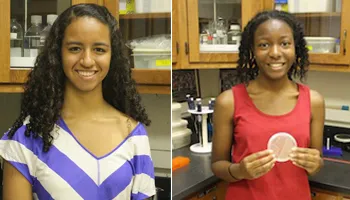Sophomores Present Work at Biomedical Research Conference

Opportunities for Swarthmore undergraduates to conduct their own research can start as early as their first year on campus. Roxanne Morris '15 and Ariel Parker '15 not only had that opportunity last summer, but they presented their findings - on the universal stress protein in Escherichia coli - at the Annual Biomedical Research Conference for Minority Students (ABRCMS) in San Jose, Calif., last fall.
Morris and Parker attended the conference with Professor of Biology Amy Cheng Vollmer, in whose lab they worked together last summer. The pair unveiled their findings on posters they created, with Parker taking home an award for her presentation. Vollmer was quick to point out that, while Parker won the recognition at the meeting, Morris emerged as a leader and organizer in the lab group.
"It was amazing working with Professor Vollmer," Parker says. "She demanded that I, as well as the other students in the lab, think through problems myself. I could not have asked for a better mentor to start off my research experience."
As participants in the microbiology section of the conference, Morris and Parker demonstrated the results of their project, which focused on the universal stress protein (uspA) in E. coli. Morris, a Madbury, N.H. native, focused on the genetic engineering portion of the project while Parker, from Philadelphia, highlighted the unique outcome of their experiment - the production of a mysterious green pigment.
ABRCMS is one of the largest conferences for students pursuing undergraduate, graduate, and postdoctoral research in biomedical and behavioral sciences. Designed to highlight research done by underrepresented minority students, ABRCMS provides a chance to interact and network with graduate programs and scientists.
"The number of African-American and Latino and Latina people who apply for faculty positions are very low," Vollmer says. "The pool is very small. They are traditionally underrepresented in academics, and particularly underrepresented in the sciences."
Morris and Parker's research was supported by a grant from the Howard Hughes Medical Institute that allocates stipends for students to work on research projects for 10 weeks over the summer. In addition to Parker and Morris, this grant funded research conducted by Ted Goh '14, and partially funded Nina Kogekar '13 in Vollmer's lab last summer. Two other students on the project, Jasmeet Samra '14 and Sinan Kazaklar '14, were unpaid volunteers in the Vollmer lab.
The conference provided Morris and Parker with a chance to listen to prominent scientists, researchers, and academics. Parker found the experience of presenting her work and talking with other students and researchers to be quite affirming.
"As an African-American woman," Parker says, "it was very cool to see a room full of people of color discussing science." It's a feeling that Vollmer hoped both students would experience at the conference.
"I wanted them to attend ABRCMS because I wanted them to see themselves as part of a larger community of minority scientists," Vollmer says, "where you have a lot of role models who are involved in a breadth of science careers beyond what they see here at Swarthmore."



